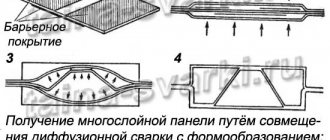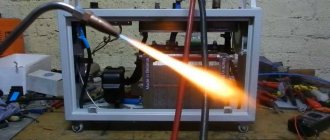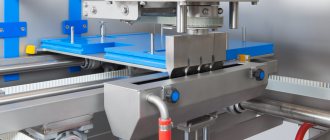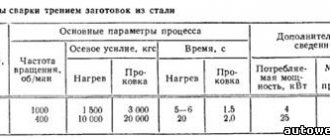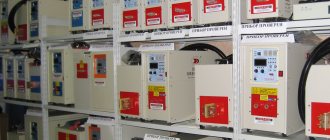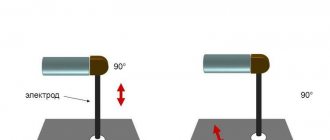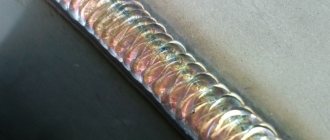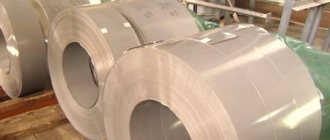Ultrasonic welding of metals
Ultrasonic welding technology is the joining of parts under the influence of ultrasonic waves, which are converted into mechanical vibrations and cause plastic deformation of the planes at the point of their contact, while simultaneously destroying oxide films. The properties of metals remain almost unchanged. The ultrasonic welding installation consists of the following components:
- power supply;
- converter;
- welding head;
- waveguides.
Electricity is converted into high-frequency sound necessary for welding, the head provides compression of the working parts, and waveguides transmit energy to the point where the surfaces are welded.
The scope of industrial application of this type of welding is quite wide. It is used to connect wire, foil, and heat-sensitive materials. It is also used in the manufacture of mobile phones, microcircuits, optical and other devices. Modern automotive industry and the production of audio equipment also cannot do without ultrasonic welding. This method is valued for its high productivity, accuracy and strength, as well as its ability to weld various alloys for which conventional welding is not possible.
Equipment
Since we've mentioned equipment twice, let's take a closer look at this topic. There are three types of ultrasonic welding machines:
- Devices performing spot-contour welding
- Welders performing seam or seam-step welding
- Mobile (portable) low-power devices, for example, welding guns.
In this case, the power of the device can be from 100 to 1500 W, depending on its price, purpose and size.
Welding machines produced before the end of the 70s used the magnetostrictive principle of ultrasound generation. But at the moment, such devices are not produced; they have been replaced by installations in which ultrasound is generated using a built-in piezoelectric transducer.
At the moment, such equipment is produced by many countries in Europe and the world, including Russia. The quality of domestic products is quite acceptable, especially considering the low cost compared to foreign competitors. In general, the production of ultrasonic welding machines began in the Soviet Union. At that time, such devices were mainly used for welding microcircuits. Now the scope of application has become much wider.
Advantages of ultrasonic welding
This type of welding is widely used and has proven numerous advantages:
- The absence of strong heating allows you to weld even those metals that are characterized by chemical activity.
- Welding is carried out at high speed.
- The strength of the joint of dissimilar materials increases, which would be brittle at the high temperature accompanying conventional welding.
- Technological limitations associated with welding aluminum or copper are eliminated.
- The thickness of ultrasonic welded parts is not limited; they can be thin or even ultra-thin (for example, foil), and the thickness of the elements connected by welding can vary.
- The requirements for surface cleanliness when using ultrasound are less stringent than with the conventional welding method; the presence of an oxide or insulating film is allowed.
- The welding force is low, which avoids severe deformation in the joint area.
- The design of the installation for ultrasonic welding is not complicated.
Environmental safety and hygiene are also among the advantages of ultrasound technology. Such welding requires less labor, because it can be automated. Ultrasonic welding does not require consumables, which makes it extremely economical.
Advantages and disadvantages
Ultrasonic welding (like any other method) has advantages and disadvantages. Let's look at them in more detail so that you can understand for what purposes it is worth using ultrasound, and for what purposes it is better to abandon this idea.
The first advantage is that there is no need to thoroughly prepare the metal for welding. The only thing that needs to be done is to degrease the surface. All. You don't even have to remove dirt or rust. With other welding methods, the preparatory process takes a lot of time and effort, but with the use of ultrasound this problem is easily solved.
The second plus is local heating. The metal is heated only in the place where the welded joint is planned. For this reason, any metal deformation due to excessive heating is excluded. This advantage is especially noticeable when welding plastic parts.
The third plus is the ability to weld even in hard-to-reach places, and all welding is done very quickly, because the metal manages to heat up in less than a second. In addition, you can easily weld very thin metal. And when we say “thin,” we even mean metal sheets no more than 0.001 millimeters thick. Impressive!
But, since our material is objective, we will also tell you about the shortcomings. Please note that they are not all that significant.
Firstly, in some situations you still have to purchase expensive ultrasonic wave generators if budget models cannot cope. But, to be fair, this happens extremely rarely. In our practice, there has never been a single case where an inexpensive ultrasonic generator failed to do its job.
Also, sometimes there are situations when ultrasound cannot weld thick metal. This problem can be solved by selecting concave parts. They will focus ultrasound in the welding zone and thereby even thick metal will quickly melt.
Ultrasonic micro welding
One of the types of ultrasonic welding is ultrasonic microwelding. Its main area of application is microelectronics. When semiconductor chips are mounted, jumper wires or tape are created between the pads and terminals to provide the electrical connection. Ultra-thin parts can only be welded using ultrasound, monitoring its parameters using a special installation:
- power;
- pressure;
- exposure time.
The welding process is based on the interaction of electrons with adjacent molecules; the joining of the thinnest wire occurs at the atomic level using the diffusion method. Modern devices for ultrasonic microwelding make it possible to minimize the labor intensity of the process and expand the range of materials that can be welded using this method. Welding using ultrasound is used not only for metal parts, but also for plastic products when applying spot welds.
How is ultrasonic welding performed?
Ultrasonic welding of metal is carried out due to the influence of high-frequency transverse vibrations occurring along the edges of several metal surfaces. In parallel, the structures to be welded are mounted to each other under moderately high pressure. As a result, the stress growing inside the parts leads to the appearance of elastoplastic deformations along the contour of the surface. Specifically localized butt slip between phases gradually begins to destroy metal oxides and films located on the surface, which allows structures to contact each other at once at dozens of points of contact. Oscillations of long periodicity in a short period of time completely destroy all the boundaries of the joints between the parts, increasing the area of their contact and providing a connection that is structurally reminiscent of welding by diffusion.
Ultrasonic welding causes an increase in the temperature of certain areas of metal parts. This can be achieved using a combination of plastic hysteresis, sliding between phases and plastic deformations. If you correctly set the power of the devices used, the ultrasonic welding process takes place without remelting the metal at the boundary of the structures being connected.
TIP: This type of welding is best suited for metals with low thermal conductivity (such as steel). The reason for this is the high resistance of such materials - their welding using ultrasound requires much less energy than conventional welding. Therefore, it is recommended to use ultrasonic equipment to connect structures made of materials with low thermal conductivity.
Ultrasonic microwelding installations
Ultrasonic welding has found wide application in microelectronics. In the modern world, almost every average person has devices assembled using nanometer technological processes (for example, a mobile smartphone). Thus, the need to create a workplace for a micro-welder is becoming obvious, and the need for specialized micro-welding equipment is becoming more and more urgent.
Let's look at the main ultrasonic microwelding devices.
1. The UMS-1AK installation is designed for automatic and semi-automatic ultrasonic and thermosonic welding of gold wire using the “ball-wedge” method and aluminum and gold wire using the “wedge-wedge” method. The automatic installation is controlled using a specialized control system based on a personal computer, which allows programming up to 100 technological parameters: height, length, jumper angle, etc. 2. The installation is equipped with a machine vision system for recognizing patterns of contact pads of semiconductor devices. The installation is equipped with an ultrasonic generator with the ability to automatically adjust the resonant frequency during the welding pulse, using ultrasonic piezoceramic transducers with a resonant frequency of 62 kHz; 108 kHz. 3. Ultrasonic micro-welding machine UMS-1UT is used for ultrasonic lap welding of aluminum and gold wires “wedge-wedge”. The installation is equipped with an additional manual mechanical drive for lowering the welding head along the Z axis using a “handle” for the purpose of precise positioning of the welding electrode relative to the contact pad and for prompt correction of the welding level with a difference in height of up to 6 mm and a “well” depth of up to 18 mm (with a length of electrode 21 mm, 3 mm remain for securing the electrode in the ultrasonic transducer). 4. The UMS-2ShK installation is designed for automated thermosonic welding of gold wire leads using the “ball-wedge” method, with additional fastening of the “wedge” with a “ball”, with the possibility of attaching gold balls to contact pads (bumping) and “overlapping” using the “wedge-wedge” method. wedge" In addition, the installation is designed for automated ultrasonic welding of aluminum wire and tape welding. 5. The UMS-21U ultrasonic welding installation is used for ultrasonic welding of aluminum wire with a diameter from 100 microns to 500 microns with an overlap using the wedge-wedge method. The installation is manufactured in two versions: when assembling devices with wire with a diameter of 100 to 350 microns, the wire is separated from the second welded joint using clamping jaws; when installing with wire with a diameter of 400-500 microns with cutting the welding wire after the second welding using a “knife”. 6. Ultrasonic welding installation UMS-2TKU, designed for point connection of gold wire leads with a diameter of 15 to 50 microns to contact pads without body diodes using thermocompression and thermosonic microwelding (for wire mounting of hybrid integrated circuits).
Technology
The work uses a special ultrasonic welding machine, which, when turned on, continuously generates ultrasonic waves with a frequency of 18 to 180 kHz. At the same time, it can produce power from 0.01 to 10 kW. As a result, high-frequency vibrations are created, which generate heat and, in conjunction with high pressure, weld the parts. Additionally, the workpiece can be heated at the welding site using a separate device, so the connection is of a higher quality. This is a short description. A detailed description of the welding process can be described as follows: high-frequency vibrations collide with the parts and dry particle friction is generated. If the metal is covered with an oxide film, then under the action of dry friction it is destroyed. After which pure friction is formed, during which the metal melts and a welding joint is formed.
Ultrasonic metal welding can be performed using a wide variety of weld joint types. You can overlap weld two parts, crush the edges and weld them, you can butt weld a round part to a flat one, and so on. In short, the possibilities are almost endless.
